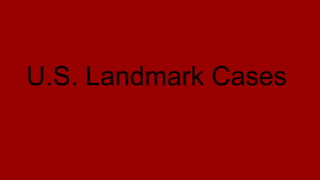
Us case law joey femia
- 2. Brown v. Board of Education ● In 1868, the 14th amendment was ratified into the United States Constitution, which granted citizenship to all people “born and naturalized” in the U.S. ● In 1877, the Jim Crow Laws were passed, which created the law commonly known as “separate but equal”. ● During the civil rights movement in 1950’s, Linda Brown and her family, the plaintiff, recognized their 14th amendment rights as a U.S. citizen and stated that segregation of schools violated their 14th amendment rights. "No State shall . . . deny to any person within its jurisdiction the equal protection of the laws.” ● The Brown family got tired of going to a separate school that was only blacks, not to mention that this segregated school was further away the the white only school right by their house, so they brought the case to court. ● They also argued how black students in segregated schools get physiologically damaged.
- 3. Brown v. Board of Education ● Even though the Federal Court knew that segregation had negative effects on black children, they saw segregation as legal because both black-only and white-only schools had the same laws with similar buildings, transportation, and teachers.
- 4. Brown v. Board of Education ● The Court decided that state laws requiring separate but equal schools violated the Equal Protection Clause of the Fourteenth Amendment. ● The U.S Supreme Court acknowledged that black children were being brainwashed into thinking that they were inferior when, by law, they weren’t.
- 5. Plessy v. Ferguson ● The Separate Car Act of 1890 stated that all railway companies in Louisiana must abide by the “separate but equal” accommodations, which means that blacks and whites had separate railway cars. ● Homer Plessy believed against the the separate but equal saws, so he purchased a ticket to a white only rail car. He said they violated the 13th and 14th amendment.
- 6. Plessy v. Ferguson ● The defendant's main argument made was that separate is equal ● Judge Ferguson stated that the state had the right to make that law, according to the 10th amendment; therefore, the state was allowed to pass these railway acts making their actions constitutional.
- 7. Plessy v. Ferguson ● The Court ruled in favor of Ferguson 7:1 ● Most of Plessy’s arguments regarding the 13th and 14th amendments were disregarded, and the justice did not believe that denying the integration “stamped the colored race with inferiority. ● The 10th, 13th, and 14th amendments were used.
- 8. ● Aaron Ogden filed a complaint that Thomas Gibbons couldn’t operate his steamboats in the New York and interstate waters because they were granted a monopoly from the New York state government to operate steamboats in this water. ● Gibbons didn’t approve of this and said according to Article 1 Section 8 of the US Constitutions only the US Congress has the power to regulate commerce with foreign nations and between states. ● Gibbons argued that the regulation of commerce relies to the US Congress under Article 1 Section 8 of the US Constitution ● He also argued that the New York state Government couldn’t grant a person regulation over interstate waters Gibbons v. Ogden
- 9. Gibbons v. Ogden •Ogden argued that according to the New York state Law he should be the only person operating his steamboats in the water •Ogden argued had the power of commerce regulation should be shared between the state and the government and the Fulton-Livingston monopoly should be upheld
- 10. Gibbons v. Ogden •The courts decided that Gibbons is allowed to operate his steamboats between New York and New Jersey because only the US Congress is allowed to regulate commerce between states the Fulton-Livingston monopoly is destroyed •Article 1, section 8 of the Constitution was used to determine the court's decision
- 11. In Conclusion... In Conclusion, Court cases prove to show the rights we have as citizens, and it informs us on whether or not we interpret our laws and constitution in a successful way.